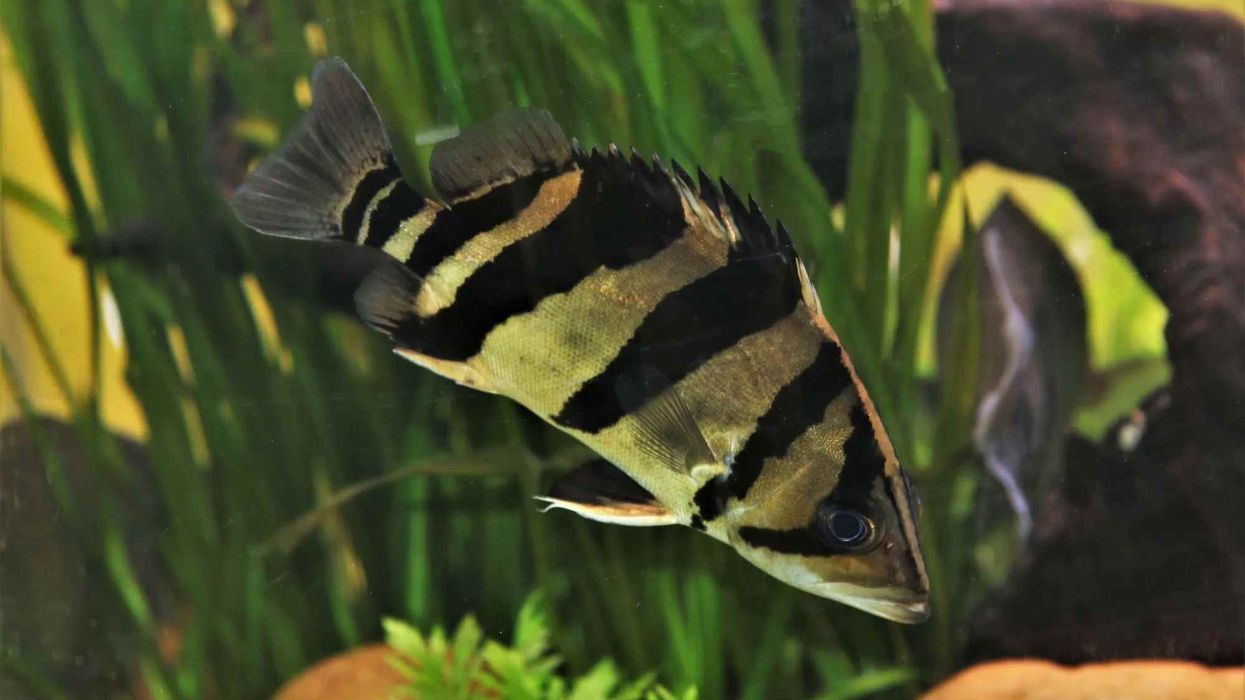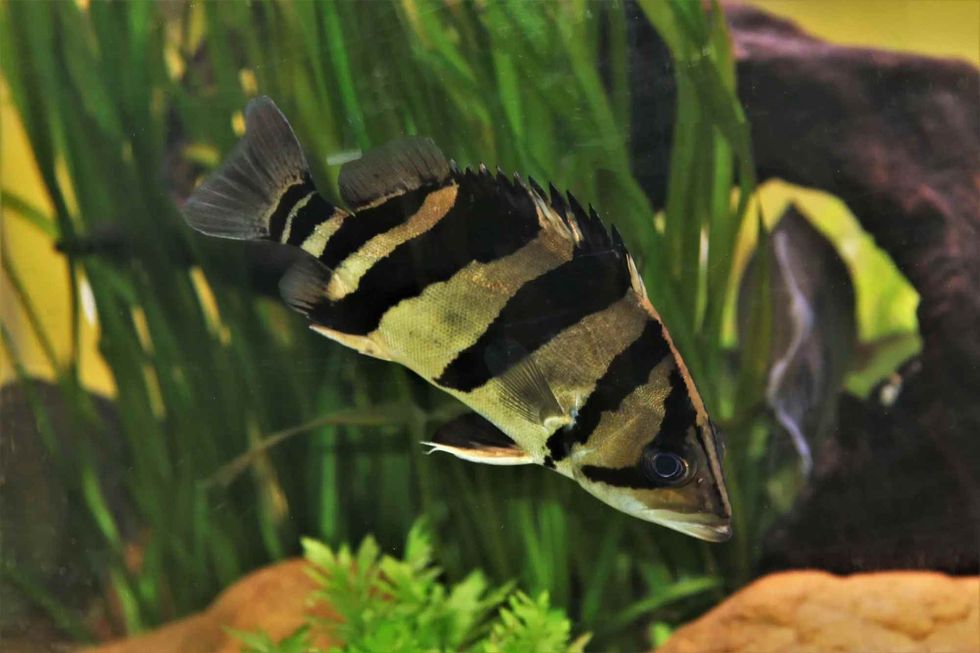Datnioides microlepis is the scientific name for Indonesian tigerfish. It is also known as Indonesian datnoid, Indonesian tiger datnoid, Indo datnoid, and finescale tigerfish.
Previously the Siamese tiger fish was considered the same as the Datnioides microlepis, but since 1998, it was considered a new species, Datnioides pulcher by Kottelat. This species is endemic to southeast Asia, namely The Malay Peninsula, Indonesia, Kapuas Basin in western Borneo, Sumatra, Chao Phraya River, and Mekong Basin.
While the Indo datnoid is listed as Least Concern in the IUCN Red List, the Siamese tiger fish is listed as Critically Endangered. This new species is currently protected in Thailand and is not part of the aquarium trade.
If you like reading about Datnioides microlepis, check out interesting facts about mutton snapper and clown triggerfish!
Datnioides Microlepis Interesting Facts
What type of animal is a Datnioides microlepis?
The Indo datnoid is a freshwater fish belonging to the Datnioididae family.
What class of animal does a Datnioides microlepis belong to?
This animal belongs to the bony class of fish, Actinopterygii.
How many Datnioides microlepis are there in the world?
The exact number of adult Indonesian tiger fish is unknown. Judging by their conservation status, there are more than 10,000 mature individuals in the world.
Where does a Datnioides microlepis live?
The Indonesian tiger fish is commonly found in Southeast Asia; the Malay Peninsula, Indonesia, Kapuas Basin in western Borneo, Sumatra, Chao Phraya River, and Mekong Basin.
What is a Datnioides microlepis' habitat?
The Indonesian tigerfish is a freshwater fish. It lives in freshwater rivers, ponds, and lakes. It can also sustain itself in slightly brackish waters like that of river estuaries. It can also live in freshwater aquariums.
Ideally, the water should be 68-82.4 °F (20-28 °C) and 5.5-7.5 pH. It lives and swims around the aquatic plants found in the brackish or freshwater river. The tank should also be decorated with some plants.
Who does Datnioides microlepis live with?
The juveniles occasionally form groups, but the adults of the Indonesian tiger datnoid species are usually found alone. They are not gregarious and get territorial around other fish from different species, fish from the same species, and similarly shaped fish.
It is best to keep them alone or in groups of more than five with large fish in a large tank size; they eat the smaller fish in the aquarium trade.
How long does a Datnioides microlepis live?
The life span of a tigerfish has been recorded to reach 15 years in captivity. The average lifespan remains to be around 10-15 years in captivity. Their age in their natural habitat has not been recorded extensively.
How do they reproduce?
The Indonesian tigerfish species reproduce by laying eggs. They are oviparous open water egg scatterers, and their eggs are fertilized outside the female's body. They are non-migratory and lay eggs in their usual habitat.
Parental care for the young is negligible. The spawning season has been observed by the locals to be from March to May. More information regarding reproduction is unavailable as reproduction or breeding has not been recorded in captivity.
What is their conservation status?
Their conservation status is listed as Least Concern in the IUCN Red List. The population of this tigerfish has seen a decrease of less than 10% in the last three generations or 10 years. It has a global population of more than 10,000 mature individuals.
Datnioides Microlepis Fun Facts
What does the Datnioides microlepis look like?
The Datnioides microlepis is a deep-bodied fish with a sharp slanted head. It can be described as a yellowish-silver color or a pale golden color. It has five black-colored full vertical bars spanning across the ventral surface of the body.
The specimens native to Borneo have been found to have six to seven such bars. The Indonesian tigerfish has three to four bars of varying sizes on its body and two identical bars placed parallelly on its tail.
The species usually does not have any partial bars present. They have 14-18 dorsal and 9-11 anal rays; fish with 10 anal rays are most common. The dark-colored vertical bars are a common feature in fish belonging to the Datnioides genus.
When under stress, these tigerfish change their appearance. The dark-colored bars on its body fade; only the borders of the bars or distinctly visible spots remain. The color of the body switches to grayish, brownish, or blackish. This is called stress coloring or nocturnal coloring. During acclimatization or transport in the aquarium trade, the fish often changes its color.

How cute are they?
Finescale tigerfish are very cute. Their distinctive tiger-like markings make them popular aquarium fish.
How do they communicate?
Information on the mode of communication exercised by the Indonesian tigerfish is not available. Since they can change their color, they can be assumed to use that ability to communicate. Since they are territorial, they may also release pheromones to establish dominance.
How big is a Datnioides microlepis?
The adult size is 1.5 ft (45.7 cm) in length, while the juvenile is 3.1-3.9 in (8-10 cm) long. The adult size is the same as a longhorn cowfish and half the size of a suckerfish. The juveniles are the same size as pumpkinseed sunfish.
How fast can a Datnioides microlepis swim?
The exact speed of this tigerfish is unknown. It usually waits stationary for its prey to come close to it and then, in quick movement, opens its jaw to suck in the target.
How much does a Datnioides microlepis weigh?
The exact weight of an Indonesian tigerfish is not known. But considering that its size is similar to that of a longhorn cowfish, it'll weigh approximately the same at around 22 lb (10 kg).
What are the male and female names of the species?
The males and females of this tigerfish species do not have different names. They are referred to as male Datnioides microlepis or female Datnioides microlepis. There are no visible physical differences between the two sexes. You cannot distinguish them just by looking at them.
What would you call a baby Datnioides microlepis?
A baby Datnioides microlepis is generally referred to as juvenile, young, or baby; there are no specific names.
What do they eat?
The diet of this freshwater fish most commonly consists of live fish. They also prey on shrimp, small fish, worms, and insect larvae as a part of their regular diet. The diet is slightly different, additionally consisting of zooplankton.
In an aquarium, it can get tricky for their caretaker to feed them frozen food pellets. They have to be slowly acclimatized to the new diet from a young age. Sometimes stubborn fish have to be starved for some time so that they start eating the frozen food.
Are they dangerous?
They are not harmful to humans and are considered moderately low on the predatory scale. These fish only display aggressive behavior towards other fish during hunting. They might cause some disturbance in an aquarium when a new tankmate is added, but the behavior will soon wane.
Would they make a good pet?
While they are popular aquarium fish, they are not common in home aquariums. This is because they are hard to maintain and can be aggressive towards the smaller tank mates.
They have specific needs when it comes to water quality; water should ideally be 68-82.4 °F (20-28 °C) and 5.5-7.5 pH. Since they also excrete a lot of waste, their tank needs to have a large external filtration unit for the water.
They are used to moderately fast-paced waters, similar to that found in a river, and require a lot of space decorated with plants to swim in.
These tigerfish are also very expensive and are commercially bred only in Indonesia. They would not make a good pet, but if you have a large home aquarium and can meet all the requirements, they will make an attractive addition to your home aquarium.
Did you know...
The datnoids are divided into five types; the Siamese tigerfish or wide bar datnoid, Indonesian tigerfish or Indonesian tiger datnoid, northern Thailand tigerfish or thin bar datnoid, American tigerfish or silver tiger, and New Guinea tigerfish or New Guinea datnoid.
Sometimes, the Datnioides pulcher (Siamese tiger fish) and Datnioides microlepis (Indonesian tigerfish) display the unique behavior of engaging in hunger strikes. This problem can be solved by adding other live fish in the tank, which devours their food quickly. After noticing how fast the other fish ate the food, the tigerfish will also start eating again.
Is the Datnioides microlepis aggressive?
They usually live with other aquarium species. It is best to avoid making small live fish their tankmates as they are a predator.
The tigerfish stalks its prey and uses its sizeable protrusible jaw to suck the fish into its mouth. These fish only display aggressive behavior towards other fish during hunting. They might cause some disturbance in an aquarium when a new tankmate is added, but the behavior will soon wane.
Datnoids can also become very tame towards humans. They will eventually grow used to your presence during their long life span in captivity. There are reports of caretakers being able to feed the fish directly from their hands.
How fast do Datnoids grow?
A common feature of Datnioides genus fishes is that they have an extended life span. They grow slowly in their first few years of life and are often seen as juveniles in aquariums.
They grow to a foot long until their middle age. Eventually, they reach their maximum size of around 16-18 in (40.6-45.7 cm) in several years, only under proper living conditions and a healthy diet.
Here at Kidadl, we have carefully created lots of interesting family-friendly animal facts for everyone to discover! For more relatable content, check out these skate fish facts and drum fish facts for kids.
You can even occupy yourself at home by coloring in one of our free printable Datnioides microlepis coloring pages.
Second image by Ginkgo100.









